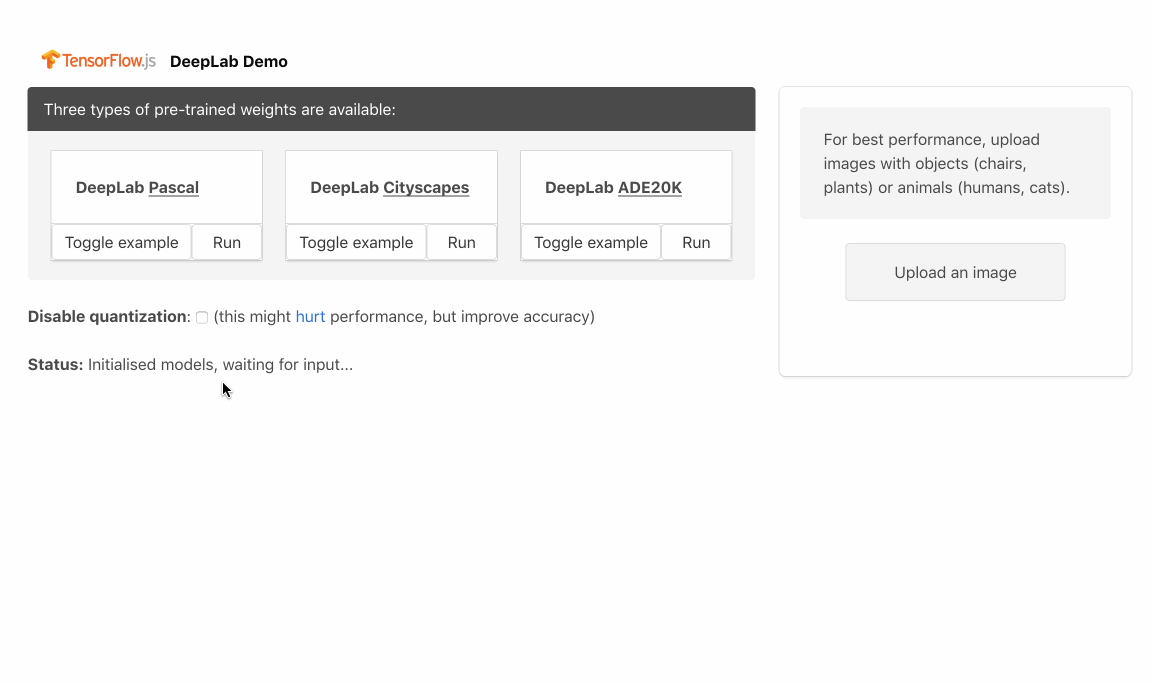tfjs-models
Semantic Segmentation in the Browser: DeepLab v3 Model
This package contains a standalone implementation of the DeepLab inference pipeline, as well as a demo, for running semantic segmentation using TensorFlow.js.

Usage
In the first step of semantic segmentation, an image is fed through a pre-trained model based on MobileNet-v2. Three types of pre-trained weights are available, trained on Pascal, Cityscapes and ADE20K datasets.
To get started, pick the model name from pascal, cityscapes and ade20k, and decide whether you want your model quantized to 1 or 2 bytes (set the quantizationBytes option to 4 if you want to disable quantization). Then, initialize the model as follows:
const tf = require('@tensorflow-models/tfjs');
const deeplab = require('@tensorflow-models/deeplab');
const loadModel = async () => {
const modelName = 'pascal'; // set to your preferred model, either `pascal`, `cityscapes` or `ade20k`
const quantizationBytes = 2; // either 1, 2 or 4
return await deeplab.load({base: modelName, quantizationBytes});
};
const input = tf.zeros([227, 500, 3]);
// ...
loadModel()
.then((model) => model.segment(input))
.then(
({legend}) =>
console.log(`The predicted classes are ${JSON.stringify(legend)}`));
By default, calling load initalizes the PASCAL variant of the model quantized to 2 bytes.
If you would rather load custom weights, you can pass the URL in the config instead:
const deeplab = require('@tensorflow-models/deeplab');
const loadModel = async () => {
const url = 'https://tfhub.dev/tensorflow/tfjs-model/deeplab/pascal/1/default/1/model.json?tfjs-format=file';
return await deeplab.load({modelUrl: url});
};
loadModel().then(() => console.log(`Loaded the model successfully!`));
This will initialize and return the SemanticSegmentation model.
You can set the base attribute in the argument to pascal, cityscapes or ade20k to use the corresponding colormap and labelling scheme. Otherwise, you would have to provide those yourself during segmentation.
If you require more careful control over the initialization and behavior of the model (e.g. you want to use your own labelling scheme and colormap), use the SemanticSegmentation class, passing a pre-loaded GraphModel in the constructor:
const tfconv = require('@tensorflow/tfjs-converter');
const deeplab = require('@tensorflow-models/deeplab');
const loadModel = async () => {
const base = 'pascal'; // set to your preferred model, out of `pascal`,
// `cityscapes` and `ade20k`
const quantizationBytes = 2; // either 1, 2 or 4
// use the getURL utility function to get the URL to the pre-trained weights
const modelUrl = deeplab.getURL(base, quantizationBytes);
const rawModel = await tfconv.loadGraphModel(modelUrl);
const modelName = 'pascal'; // set to your preferred model, out of `pascal`,
// `cityscapes` and `ade20k`
return new deeplab.SemanticSegmentation(rawModel);
};
loadModel().then(() => console.log(`Loaded the model successfully!`));
Use getColormap(base) and getLabels(base) utility function to fetch the default colormap and labelling scheme.
import {getLabels, getColormap} from '@tensorflow-models/deeplab';
const model = 'ade20k';
const colormap = getColormap(model);
const labels = getLabels(model);
Segmenting an Image
The segment method of the SemanticSegmentation object covers most use cases.
Each model recognises a different set of object classes in an image:
model.segment(image, config?) inputs
-
image ::
ImageData | HTMLImageElement | HTMLCanvasElement | HTMLVideoElement | tf.Tensor3D;The image to segment
-
config.canvas (optional) ::
HTMLCanvasElementPass an optional canvas element as
canvasto draw the output -
config.colormap (optional) ::
[number, number, number][]The array of RGB colors corresponding to labels
-
config.labels (optional) ::
string[]The array of names corresponding to labels
By default,
colormapandlabelsare set according to thebasemodel attribute passed during initialization.
model.segment(image, config?) outputs
The output is a promise of a DeepLabOutput object, with four attributes:
-
legend ::
{ [name: string]: [number, number, number] }The legend is a dictionary of objects recognized in the image and their colors in RGB format.
-
height ::
numberThe height of the returned segmentation map
-
width ::
numberThe width of the returned segmentation map
-
segmentationMap ::
Uint8ClampedArrayThe colored segmentation map as
Uint8ClampedArraywhich can be fed intoImageDataand mapped to a canvas.
model.segment(image, config?) example
const classify = async (image) => {
return await model.segment(image);
}
Note: For more granular control, consider predict and toSegmentationImage methods described below.
Producing a Semantic Segmentation Map
To segment an arbitrary image and generate a two-dimensional tensor with class labels assigned to each cell of the grid overlayed on the image (with the maximum number of cells on the side fixed to 513), use the predict method of the SemanticSegmentation object.
model.predict(image) input
-
image ::
ImageData | HTMLImageElement | HTMLCanvasElement | HTMLVideoElement | tf.Tensor3D;The image to segment
model.predict(image) output
-
rawSegmentationMap ::
tf.Tensor2DThe segmentation map of the image
model.predict(image) example
const getSemanticSegmentationMap = (image) => {
return model.predict(image)
}
Translating a Segmentation Map into the Color-Labelled Image
To transform the segmentation map into a coloured image, use the toSegmentationImage method.
toSegmentationImage(colormap, labels, segmentationMap, canvas?) inputs
-
colormap ::
[number, number, number][]The array of RGB colors corresponding to labels
-
labels ::
string[]The array of names corresponding to labels
-
segmentationMap ::
tf.Tensor2DThe segmentation map of the image
-
canvas (optional) ::
HTMLCanvasElementPass an optional canvas element as
canvasto draw the output
toSegmentationImage(colormap, labels, segmentationMap, canvas?) outputs
A promise resolving to the SegmentationData object that contains two attributes:
-
legend ::
{ [name: string]: [number, number, number] }The legend is a dictionary of objects recognized in the image and their colors.
-
segmentationMap ::
Uint8ClampedArrayThe colored segmentation map as
Uint8ClampedArraywhich can be fed intoImageDataand mapped to a canvas.
toSegmentationImage(colormap, labels, segmentationMap, canvas?) example
const base = 'pascal';
const translateSegmentationMap = async (segmentationMap) => {
return await toSegmentationImage(
getColormap(base), getLabels(base), segmentationMap)
}
Contributing to the Demo
Please see the demo documentation.
Technical Details
This model is based on the TensorFlow implementation of DeepLab v3. You might want to inspect the conversion script, or download original pre-trained weights here. To convert the weights locally, run the script as follows, replacing dist with the target directory:
./scripts/convert_deeplab.sh --target_dir ./scripts/dist
Run the usage helper to learn more about the options:
./scripts/convert_deeplab.sh -h